The San Francisco School
of Needlework & Design
Moving the Needle Forward
This article originally appeared in the September 2017 issue of Needle Arts magazine.
Written by Ellice Sperber
I met Lucy Barter in 2012 when I enrolled in the Royal School of Needlework (RSN) Certificate and Diploma Program. After decades of stitching, I decided to challenge my expertise by advancing my technical skills and exploring my creativity in designing my own needlework pieces. A friendship developed between Barter, my tutor, and me when we discovered that we shared a dream to pass embroidery on to future generations.
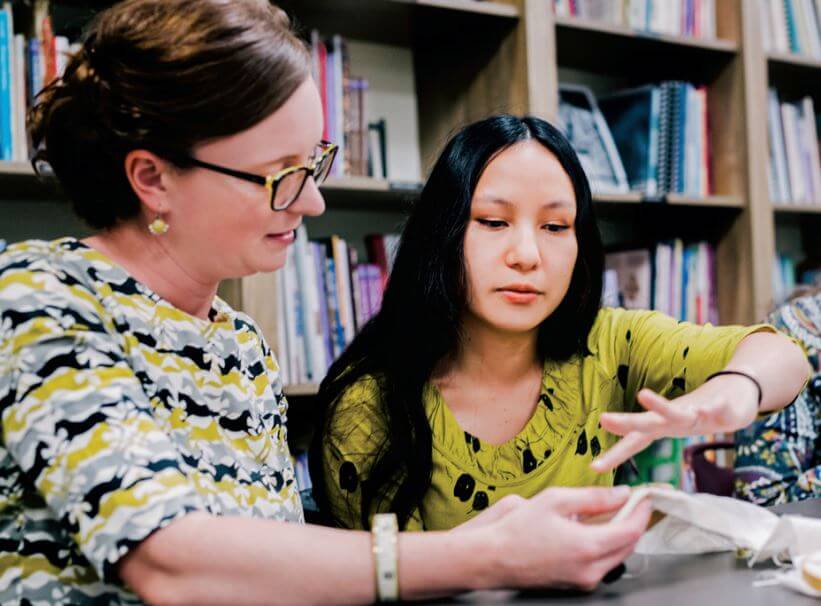
Participating in the RSN Certificate and Diploma Program over two years gave me the opportunity to not only explore my own needs as an embroiderer, but to listen to the wishes and expectations of other pupils as my peers. From a tutor’s perspective, Barter experienced the passions of individual students and the nuances of how each course impacted students’ artistic expression and their personal and creative goals. Over time, our conversations grew to include the birth of a needlework school built around our shared experiences and our desire to deliver exemplary instruction to students.
In 2015, we founded the San Francisco School of Needlework & Design (SNAD). Through coursework, an extensive library, exhibitions, and community events, our mission is to ensure a future for needlework by sharing the knowledge and history of hand embroidery and needlework.
We officially opened the school in June 2016. Every day we learn from our growing community of intergenerational students to create both traditional and contemporary works from historic examples and methods.
Barter and I came to embroidery in different ways, but it has served as a continuous thread throughout both our lives. Raised in Southern California in the 1960s, I fell in love with bargello patterns in my mother’s books, making and designing pillows before I was twelve years old. In my teens, I began dancing with an international folk ensemble and was trained to restore and reproduce embroidery in the company’s collection of intricately embroidered imported costumes. (Continue reading below)
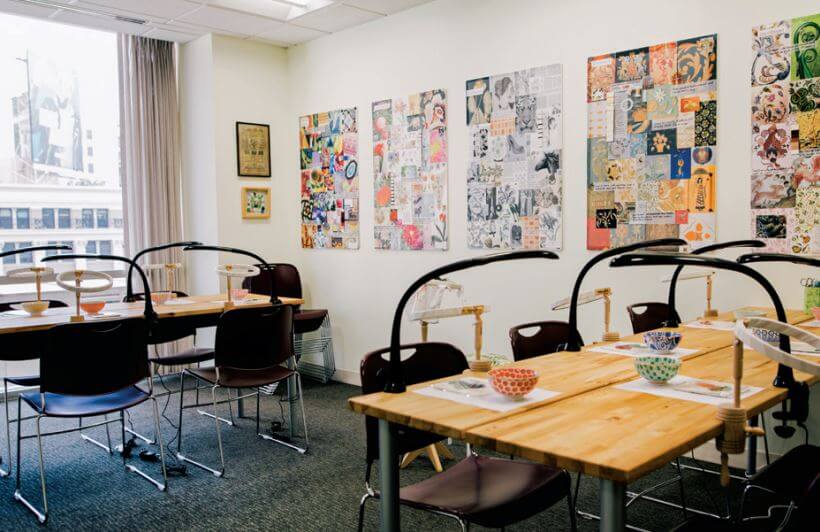
Over time, our conversations grew to
include the birth of a needlework school.
While I planned to have a career as an embroiderer, I ventured into the theater arts and spent most of my professional life working as an American Sign Language interpreter. I’ve also served on the board of directors for numerous nonprofits in the fields of disability rights and education. An avid embroiderer while raising my two daughters, I studied with many excellent teachers around the United States and opened a small embroidery restoration business, ERS Hand Embroidery, in 2014.
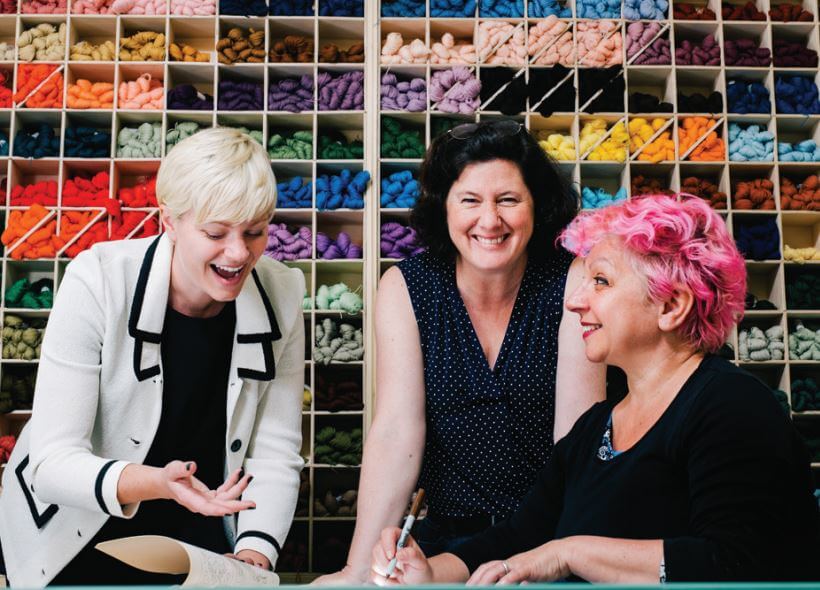
Barter is from Suffolk, England, and also began embroidering as a child. Inspired by watching her mother stitch, she began her own embroidery projects with simple kits that she was given for holidays and birthdays. She attended Northumbria University, earning a BA Honours in Fashion Design.
She then designed and embroidered clothing and bedding for children’s brands in San Francisco, but her interest in embroidery took her back to the United Kingdom to enroll in the RSN Apprenticeship Programme. She graduated with distinction at the top of her class in 2006.
When Barter returned to the U.S., she began an independent embroidery business, Forever Embroidery Studio, out of her home in San Francisco and spent eight years coordinating the U.S.-based courses for the RSN.
Barter is a renowned embroidery teacher, best known for her flexible teaching style, technical expertise, and unique ability to allow students to find their own voice. While I have studied with many embroidery teachers, Barter boosted my technical skills in a way no other instructor had before, but, most importantly, she allowed me to trust my instincts on color, texture, and design.
Having built our friendship from time spent embroidering together, Barter and I knew that community would be intrinsic to our mission and vision. The atmosphere in our school is warm, collaborative, and joyful—it even extends to our enthusiastic followers on social media. (Continue reading below)
Every Wednesday and the second Saturday of each month, we host a free stitch-in. We also provide a Stitch ‘n’ Lunch, a $5 class during lunch hour when we teach a few stitches on a simple pattern. Each week during these classes, we see new students who are eager to dip their toes into embroidery. Many of them then choose to enroll in our introductory classes or volunteer their time with us.
For the 21- to 35-year-old audience, we offer stitching evenings with wine and snacks. Sometimes teenagers come with their mothers. Our denim event with Marie-Sophie Lockhart, who works with fashion brands like Stella McCartney and Marc Jacobs, was our most popular stitching evening to date. Both of Lockhart’s classes sold out. From her large social media following, Lockhart helped bring in new students who were eager to meet others with a common interest. They bonded over personalizing their denim, later modeling their newly embroidered jeans. We are pleased to have several students from these events continuing to take classes and use our library as inspiration for design. We are also working to feature classes for young adults, age fourteen and up.
Three times a year we do a Stitch-At-Home Challenge. These Challenges sprang from an off-the-cuff idea, when we were keeping in mind our many faraway friends and family who couldn’t attend our grand opening. We decided we would exhibit the work of those who entered, sending each a limited-edition canvas gift bag from the opening party.
The success of our first Challenge brought in new collaborations. Through a partnership with Nest, a New York nonprofit that helps women handcrafters build businesses, Swarovski sponsored our second Challenge. The company donated 4,000 up-cycled crystals for our participants to include in their designs. We have also gained collaborations for our spring and summer Challenges: Anna Garris Goiser, the designer behind Talliaferro Classic Needleart, donated two floral patterns for our Talliaferro Challenge, and DMC donated thread packs for our Summer of Love Challenge, which will be exhibited in September 2017.
We are thrilled with the number of participants and the enthusiasm for our Challenges thus far. More than six hundred have entered from twenty-five countries, including Malaysia, New Zealand, South Africa, and Ecuador. While not part of our original vision, the Challenges have given us a global reach with artists ranging in age from fifteen to ninety years old. (Continue reading below)
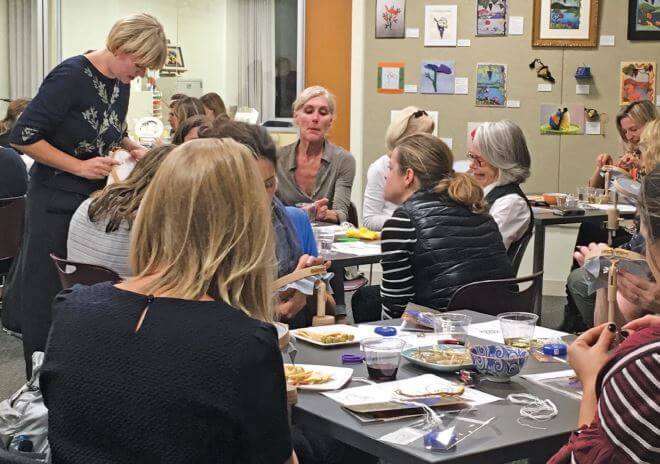
The atmosphere in our school is warm,
collaborative, and joyful . . .
Collaboration with individuals, corporations, and other nonprofits are an important part of the community that we continue to build at SNAD. The EGA San Francisco Chapter holds their monthly day meetings at our school, and we offer private instruction and create custom classes for guilds and other interested groups based on their unique interests. One recent example is a course we designed in needlelace techniques on canvas for a local American Needlepoint Guild chapter. We also offer private events for families wishing to make something special to mark important life events. The first bridal shower that we hosted was for a bride who loves robots and dinosaurs. We designed a set of dinosaur dinner napkins for the shower guests to embroider as gifts for the wedding couple. Creating unique projects and events for bridal and baby showers is our way of helping today’s busy people create what may become future heirlooms.
Barter and I felt it was important for SNAD to establish a legacy for future generations. For this reason, we decided to make the school a nonprofit entity. Obtaining our 501(c)(3) was much easier than we thought—we obtained it within six weeks of applying—and helped us define our mission.
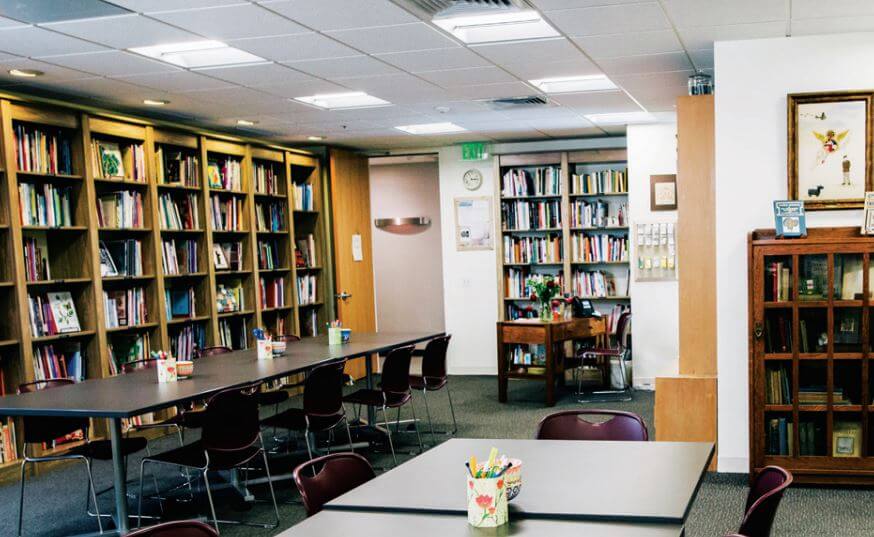
But it wasn’t all smooth sailing. We struggled for eighteen months to find a space for the school, scouring San Francisco with Barter’s two babies in tow. We were lucky to land at our current location on Union Square, in the heart of the city’s downtown.
Since our founding, we’ve built a Board of Directors, which in addition to Barter and me, consists of Meryl Macklin, an attorney who actively practices a wide range of arts and crafts; Sarah Halsey, our treasurer and president of The Bay Area Sampler Guild; and our two newest members, June Dershewitz and Pauline Basaran.
Operationally, I serve as CEO; Barter serves as our program director and head teacher; and Annalee Levin, a graduate of the RSN Future Tutor Programme, serves as our second instructor and community outreach coordinator. Among the three of us, we are incredibly fortunate to have a mix of creative skills, interests, and energies: Barter is the champion of beautiful and traditional designs; Levin, with an MFA in sculpture from the School of the Art Institute of Chicago, brings us designs that are both contemporary and experimental in nature; and I round out the group by sharing my knowledge of ethnic and historic embroidery.
Now after our first year, we offer classes to satisfy everyone from beginners to highly-skilled embroiderers. All of our classes are taught with a common pedagogy that emphasizes personalized instruction and exploration of individual creativity. A guiding principle of the school is to price our classes thoughtfully and affordably, offering scholarship-priced seats in almost
every class. (Continue reading below)
We offer a series of introductory classes that are vastly popular and continue to bring new students to the school each month. Our curriculum also includes a number of pre-designed classes in a variety of techniques: whitework, blackwork, needlepainting, stumpwork, crewel, canvaswork, appliqué, and metalwork. We have built contemporary classes into the program as well, such as Sketching with Thread, Plein Air Embroidery, Experimental Stitches, Stitching on Found Objects, and Portrait Embroidery.
Our Stitch Retreats are five- to ten-day intensive courses that we consider to be our core artistic program. These retreats were designed as a place for experienced stitchers to develop pieces in a technique of their choice with instructional support from the planning and design stages through execution of the piece. One student realized a passage from The Nutcracker, creating an entire snow scene with glistening needlelace and a host of stumpwork ballerinas. In contrast, another student worked a striking appliqué of a woman on a bright and colorful patchwork background with embroidered flowers highlighting the scene.
As part of our mission, the school maintains a library of more than 2,400 books, including some rare and antiquarian volumes, the oldest dating to 1841. While we are not a lending library, we welcome anyone to read and study the books on site. Decorative Needlework (1893) by May Morris and The Lady’s Manual of Fancy-Work (1858) by Mrs. Pullin are particularly popular books in our library.
Our collection also includes a growing number of embroidered textiles. We have a range of items including household linens, religious and political embroideries, ethnic costumes, and fashion accessories, as well as samplers, which we use for study, exhibition, and examples for our classes.

As with our library, we welcome donations into the textile collection. As the school grows, we hope to acquire works in many different techniques from a wide range of cultures and periods to share with our students.
This is just the beginning for SNAD. Our future plans include broadening our offerings for all kinds of students. In response to their feedback, we have created shorter entry-level options for those just getting started—“bite-sized” beginner projects using contemporary designs inspired by popular culture and fashion trends. These classes are distinguished from our introductory courses as they are three hours in length with a goal to complete a project in the class time.
On the other side of the spectrum is our Master Skills Certificate Program, which we plan to put into effect in 2018. This program will provide breadth and depth for each technique that we offer, including a foundation, a technical, and a creative level. The history and culture of each technique will be explored, and each level will allow for experimentation in designing final projects. Ongoing consultation and a final portfolio review will support and inform students as they progress. Upon completion, students will earn a certificate in their technique of study: whitework, blackwork, needlepainting, stumpwork, crewel, canvaswork, appliqué, or metalwork.
We are looking forward to designing and hosting classes for the EGA’s 2019 Extended Study Program. Until then, get involved by signing up for our newsletter and joining a Stitch-At-Home Challenge. Our ultimate vision is that the school will be passed to future generations as a place to where people can always enjoy the practice of hand embroidery.
Ellice Sperber received her RSN Diploma in 2014. She danced with a folk ensemble in Los Angeles, California, where she worked on the company’s collection of Bulgarian, Serbian, and Croatian costumes.
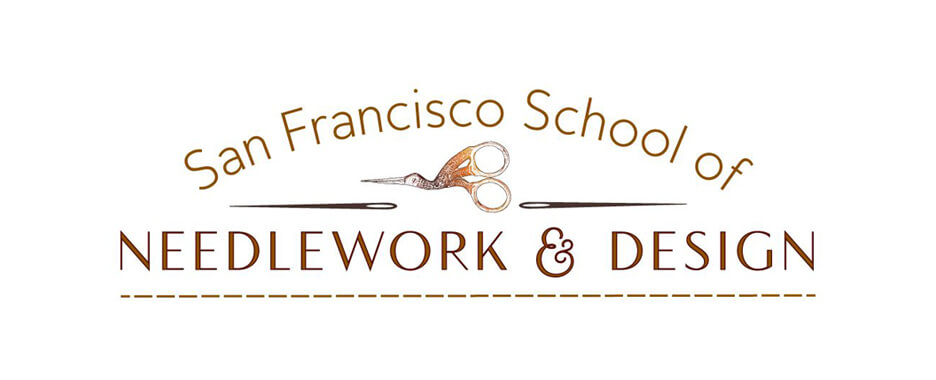
Visit San Francisco School of Needlework & Design online below or in person at 360 Post Street, Suite 604 in San Francisco, CA.
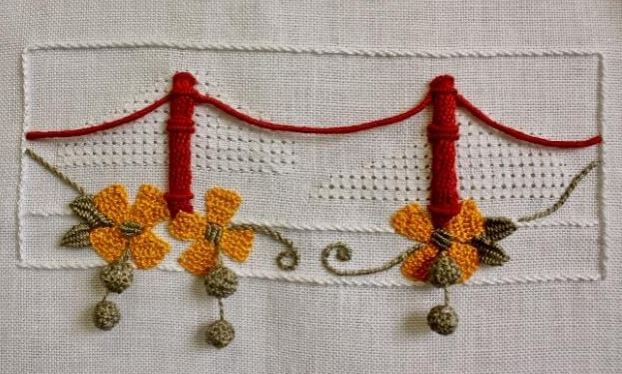
Extended Study Program
Participate in Casalguidi and Silk Ribbon Embroidery classes at the SNAD,
tour the Lacis Museum of Lace and Textiles in Berkeley
and more locations in the San Francisco Area.